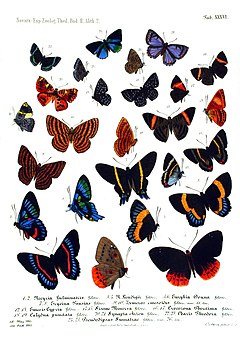Riodinidae
| Riodinidae | |
|---|---|
 |
|
| Riodinidae, from Reise der Osterreichischen Fregatte Novara um die Erde (1861–1876) | |
| Scientific classification | |
| Kingdom: | Animalia |
| Phylum: | Arthropoda |
| Class: | Insecta |
| Order: | Lepidoptera |
| Suborder: | Ditrysia |
| Infraorder: | Rhopalocera |
| Superfamily: | Papilionoidea |
| Family: |
Riodinidae Grote, 1895 |
| Subfamilies | |
|
Euselasiinae |
|
Euselasiinae
Nemeobiinae (but see text)
Riodininae
Riodinidae is the family of metalmark butterflies. The common name "metalmarks" refers to the small metallic-looking spots commonly found on their wings. There are 1532 species and 146 genera of metalmark butterflies in the world. Although mostly neotropical in distribution, the family is represented both in the Nearctic and the Palearctic.
The family includes small to medium-sized species, from 12 to 60 mm wingspan, often with vibrant structural colouring. The wing shape is very different within the family. They may resemble butterflies in other groups, some are similar to Satyrinae, some are bright yellow reminiscent of Coliadinae and others (examples Barbicornis, Rhetus arcius, Helicopis, Chorinea) have tails as do Papilionidae. The colouration ranges from muted colours in the temperate zone species to iridescent blue and green wings and transparent wings in tropical species. The golden or silvery metallic spots on the wings in many species of the Americas gave them the English common name "metalmarks". A number of species mimic poisonous moths of several families and there are often extensive mimicry rings of similar-looking species, grouped around a model. Mimicry causes often closely related species to have completely different wing patterns, for example the genus Thisbe. Many species mimic the stain and stripe pattern of toxic Nymphalidae. Batesian mimicry seems to be more common than in any other insect family of similar size. Reasons for this are unknown. Another example is Ithomeis where different subspecies resemble the species they mimic in different parts of the geographic range more than they resemble each other.
...
Wikipedia
